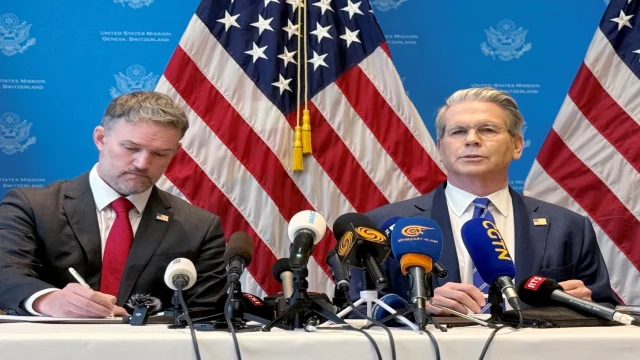Washington, May 13 (V7N) — In a major breakthrough aimed at defusing long-standing economic tensions, the United States and China announced on Monday that they have agreed to a significant rollback of reciprocal tariffs, marking a critical step toward ending a trade war that has rattled global markets, driven up inflation, and stoked fears of recession in recent years.
Tariff Reductions Mark a Turning Point
Speaking at a press conference in Washington, U.S. Treasury Secretary Scott Bessent confirmed that both nations will drastically reduce tariffs that were imposed amid escalating trade disputes. The United States will lower additional tariffs on Chinese goods from 145% to 30%, while China will cut its retaliatory tariffs on U.S. products from 125% to 10%. The revised tariffs will be in effect for an initial 90-day period, during which both sides are expected to continue negotiations toward a more permanent agreement.
“These cuts represent over 100 percentage points in reciprocal reductions. It is a significant de-escalation of the trade war,” Bessent told reporters.
Immediate Market Reaction
News of the agreement sent U.S. financial markets soaring. The Dow Jones Industrial Average jumped more than 800 points in early trading, while the S&P 500 and Nasdaq also posted strong gains. Analysts credited the rebound to renewed investor optimism about global trade stability and easing inflationary pressures.
Trump Hails "Victory for American Industry"
President Donald Trump addressed the media early Monday, calling the deal a “victory for American industry and consumers.” He outlined the key components of the agreement, emphasizing China’s commitment to:
Open its domestic markets to U.S. businesses, particularly in sectors such as finance, agriculture, and technology.
Eliminate non-tariff trade barriers, such as licensing restrictions and intellectual property hurdles, which U.S. companies have long argued are unfair.
Combat the flow of synthetic opioids such as fentanyl into the United States—an issue that has become a top priority in U.S.-China discussions in recent years.
“We’re not just talking about economics. We’re talking about saving lives,” Trump said, referring to China’s promise to crack down on fentanyl exports.
Background: Years of Escalation
The U.S.-China trade war began in earnest in 2018, when both countries began imposing tit-for-tat tariffs on hundreds of billions of dollars' worth of goods. The conflict has since impacted global supply chains, contributed to rising costs for consumers and manufacturers, and complicated diplomatic ties between the two superpowers.
While several attempts were made over the years to broker a deal, progress remained elusive due to deep disagreements over market access, intellectual property rights, currency policies, and geopolitical concerns.
Next Steps
Though the current tariff reductions are temporary, both sides have expressed optimism that they could pave the way for a broader, more comprehensive trade pact. According to U.S. trade officials, follow-up meetings are scheduled in Geneva and Beijing later this month, where negotiators will aim to turn the 90-day window into a long-term settlement.
“This is not the end — it’s a fresh beginning,” said an official close to the talks. “But it’s the clearest sign yet that both Washington and Beijing are ready to move forward.”
END/WD/SMA/






























Comment: